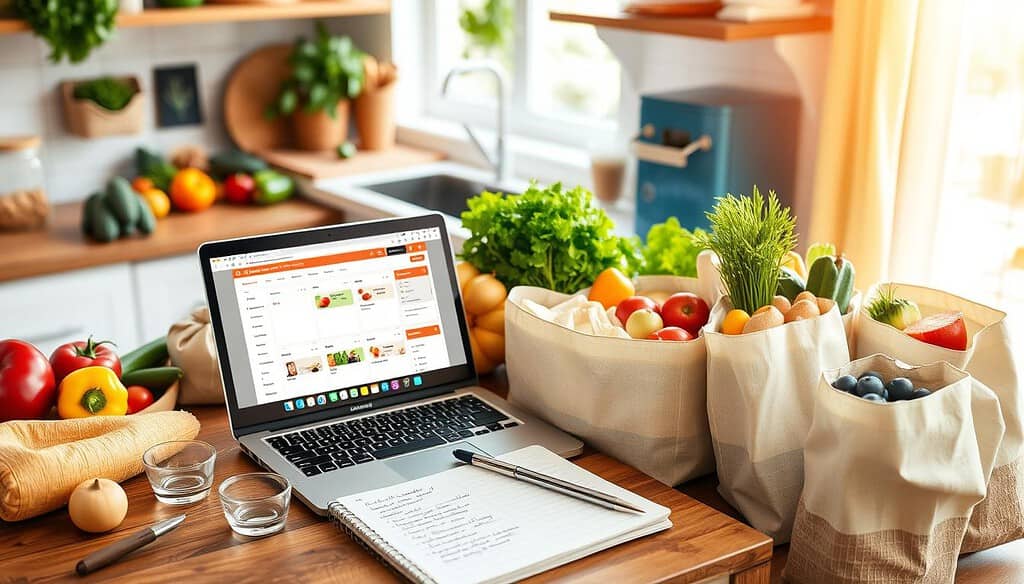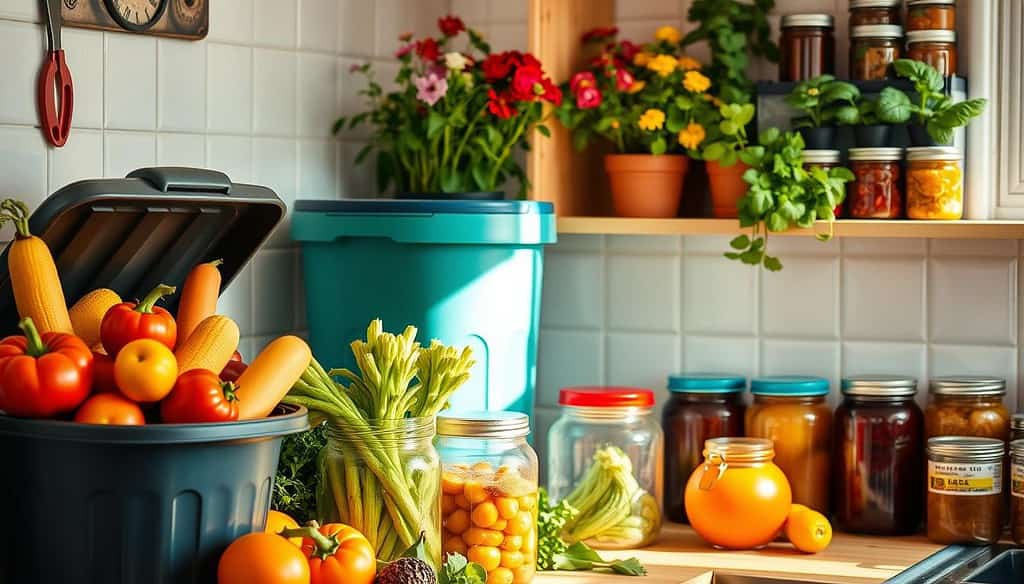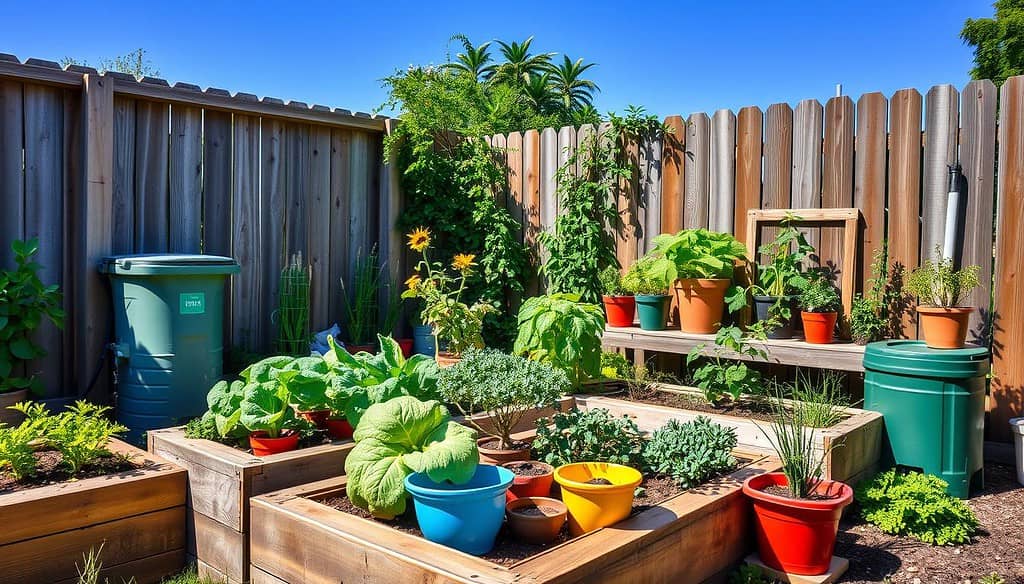Are you a mom wanting to save on groceries? I’ve found a way to feed my family of eight for just $250 a month. That’s right, $250, and we don’t eat just ramen noodles and spam.
By using smart shopping and cooking tricks, I’ve been debt-free for over 20 years. So, are you ready to learn my secrets and stretch your grocery dollars? Let’s get started!
Key Takeaways
- Grocery shopping is one of the biggest expenses for most families, often surpassing housing costs.
- Implementing smart shopping strategies and meal planning can help you save hundreds on your monthly grocery bill.
- Buying in bulk, utilizing coupons, and taking advantage of store loyalty programs are just a few ways to cut costs.
- Preserving and freezing foods can extend their shelf life and prevent waste, leading to significant savings.
- Mastering the art of smart food storage and preparation can help you make the most of your grocery budget.
Essential Grocery Budgeting Tips for Smart Shopping
As a busy mom, saving money on groceries is tough. But, with smart tips, you can cut down your weekly costs. Here are some key tips to help you save more.
Creating a Realistic Monthly Food Budget
First, figure out a good monthly budget for food. Look at how much you’ve spent before. Think about any big events or changes in your family. Then, set a budget that fits your financial goals. This way, you won’t spend too much.
Understanding Store Sales Cycles
Learn when your local stores offer discounts. Stores often have patterns for sales. Knowing these patterns lets you buy things when they’re cheapest. This can save you a lot on things you buy often.
Using Store Loyalty Programs Effectively
Many stores have loyalty programs. These give you special discounts and perks. Sign up for these programs. They can help you save up to 50% on your shopping.
Managing your grocery budget can be hard. But, with the right strategies, you can save a lot each month. By setting a good budget, knowing when to buy, and using loyalty programs, you’ll be a smart shopper.
Strategic Meal Planning to Reduce Food Costs
As a busy mom, meal planning is key to saving money. Use sale items and leftovers to cut costs. Also, try more meat-free meals to save money.
Building Meals Around Sale Items
Check the weekly ads before shopping. Plan meals with items on sale. This way, you save money on proteins, produce, and pantry items.
Making the Most of Leftovers
Turn leftovers into new dishes to save money and reduce waste. Get creative with leftovers. Make soups, casseroles, or new lunch ideas. Freezing extra portions helps too.
Planning Meat-Free Meals
Meat is often pricey. Plan more plant-based meals to save. Use beans, lentils, eggs, and tofu for affordable protein. Try soups, stews, and pasta dishes without meat.
With planning and creativity, you can save on meals. Meal planning is a great skill for frugal moms!

Smart Food Storage and Preservation Methods
Being a smart mom means knowing how to save food and money. Freezing milk when it’s cheap is a great way to save. Making your own salad dressings and baked goods also cuts down costs.
Blending and freezing greens is a smart move. It makes adding them to smoothies easy. Also, can or freeze fruits and veggies when they’re in season. This way, you save money all year.
Keep your fridge organized by storing produce in sight. This helps you remember what you have and avoid waste.
2. Leverage Bulk Buying for Big Savings
Buying in bulk can save you a lot of money. For example, a big bag of pumpkin seeds might cost less than a small bag. Non-perishable items like grains and nuts are also cheaper in bulk.
Make sure to check the price per unit. This ensures you’re getting the best deal. But, be careful with perishable items. Plan your buys to avoid throwing away food.
3. Embrace Seasonal Produce for Maximum Savings
Using more seasonal fruits and veggies can save you money. They’re often cheaper and better for the planet. Frozen options can also be a cost-effective choice.
Try eating more plant-based proteins like beans and tofu. They’re good for your wallet and health.
4. Strategize Your Shopping Habits
Your shopping habits can help you save money. Plan your meals before you shop to avoid buying things you don’t need. Use store loyalty programs and look for special deals.
Choosing generic products can save you money. They often have the same quality as name-brand items but cost less. Also, check the top and bottom shelves for the best prices.

Making the Most of Your Freezer Space
As a busy mom, your freezer is a big help. It saves you time and money. You can buy in bulk, cut down on waste, and save money. Here are some smart ways to use your freezer.
Proper Freezing Techniques
Keeping your freezer at -18°C or 0°F is key. This keeps food fresh. Here’s how to store different foods:
- Meats last 3-6 months in the freezer.
- Bread stays good for 2-3 months.
- A big turkey takes 4 days to thaw in the fridge.
- Freeze fruits and veggies as purées to save space.
Bulk Buying and Freezing Tips
Buying in bulk saves money. It also cuts down on waste. Here are some tips:
- Freeze shredded meat in 2-cup portions.
- Divide meat into meal portions in gallon bags.
- Use small containers for soups to avoid leaks.
- Freeze cheese in small bags for easy use.
- Store fruits and veggies in 1-quart bags after prep.
Organizing Your Frozen Inventory
Keep your freezer organized. Label and date everything. This way, you use older items first. It helps avoid waste and makes finding things easier.
Using your freezer wisely saves money and reduces waste. Try these tips to manage your grocery budget better!
| Freezer Item | Recommended Freezer Storage Time |
|---|---|
| Meat | 3-6 months |
| Bread | 2-3 months |
| Fruits and Vegetables | 8-12 months |
| Soups and Stews | 2-3 months |
| Cheese | 6-12 months |
Growing and Making Your Own Food Essentials
One great way to save money is to grow your own herbs and veggies. Herbs can be very pricey at the store. But, they’re easy to grow at home. Start a small garden or use pots on your patio or balcony.
Not only will you save money, but you’ll also enjoy picking your own food.
2. Make Your Own Pantry Staples
Another smart move is to make your own pantry items. You can make salad dressings, marinades, sauces, and baked goods at home. This will save you a lot of money.
You’ll also know exactly what’s in your food. This means your family will eat healthier, cheaper meals.
3. Start a Bread-Making Routine
Baking your own bread is rewarding and saves money. Store-bought bread can cost $8 to $10 per loaf. By baking your own, you can save a lot.
Invest in a bread maker or learn to knead dough by hand. The savings will add up fast, especially if you bake often.
4. Swap Homegrown Produce with Friends and Neighbors
If your garden does well, swap extra produce with others. This is a great way to get more variety without spending more. You can trade zucchini for tomatoes, and so on.

| Homemade vs. Store-Bought | Savings |
|---|---|
| Homemade Bread (55-lb bag of organic wheat berries) | $1 per loaf vs. $8-$10 per loaf |
| Homemade Salad Dressing | $0.50 per 8 oz. vs. $3-$4 per 8 oz. |
| Homegrown Herbs | Pennies per serving vs. $2-$3 per bunch |
Money-Saving Shopping Strategies and Techniques
One smart tip for saving money is to compare unit prices. This helps you see the cost per ounce or pound. It lets you pick the best deal.
Just a few seconds of looking at prices can save you a lot. You might find cheaper options you didn’t see before.
2. Timing Your Grocery Trips for Maximum Savings
The best times to shop for groceries change, but end-of-week and month sales are key. Stores discount items to restock. This is when you can find great deals.
Shopping on weekday mornings or afternoons is also smart. These times are less busy. You can easily find clearance items and sales that aren’t advertised.
3. Mastering the Art of Shopping List Discipline
Sticking to your list is a great way to avoid buying things you don’t need. Before you go, check what you already have. Then, make a list of only what you need.
Don’t let yourself get distracted by other items. Staying on your list helps you save money.
| Grocery Budgeting Tip | Potential Savings |
|---|---|
| Comparing unit prices | Up to 25% on individual items |
| Shopping at optimal times | 10-15% in markdowns and sales |
| Sticking to a shopping list | 20-30% reduction in impulse buys |
Using these grocery budgeting tips can save you a lot. Tips like coupon clipping and using a spending tracker help. A little effort can make a big difference in your grocery bill.

Conclusion
Using these 15 smart tips can cut your food costs a lot. You can still eat healthy meals with your family. Try meal planning, smart shopping, growing food, and using your freezer.
Even small changes can save a lot of money over time. Stick to your frugal ways and find new ways to save. You can eat well and save money without losing taste.
Take on the challenge of saving money on groceries. Let these tips help you shop smarter and save more. Your wallet and taste buds will be happy!